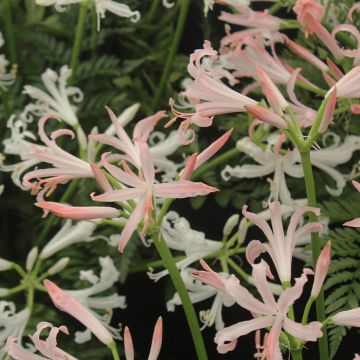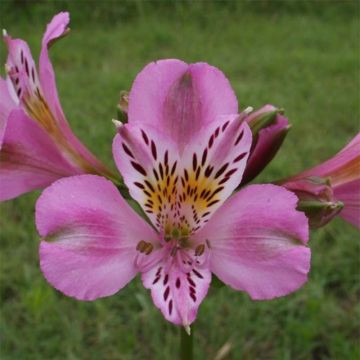

Nerine Pearls of Cherry
Nerine Pearls of Cherry
Nerine elegance Pearls of Cherry
Guernsey Lily, Spider Lily
Why not try an alternative variety in stock?
View all →This plant carries a 6 months recovery warranty
More information
We guarantee the quality of our plants for a full growing cycle, and will replace at our expense any plant that fails to recover under normal climatic and planting conditions.
From €5.90 for pickup delivery and €6.90 for home delivery
Express home delivery from €8.90.
Does this plant fit my garden?
Set up your Plantfit profile →
Description
Nerine Pearls of Cherry is a remarkably colourful variety of Guernsey Lily, with vibrant cherry red flowers in late summer. Its lightly scented flowers, with thin and wavy petals, are gathered in umbels at the top of stems that emerge from the ground while the foliage is still absent. The foliage reappears after flowering, in the form of ribbon-like leaves arranged in small tufts that persist in winter. It is well adapted to the Mediterranean climate and is best to grow this superb bulbous plant in pots that you can shelter in winter in colder regions.
Nerine Pearls of Cherry belongs to the Amaryllidaceae family. The botanical species from which it originates is called "Cape Flower" due to its South African origins. According to legend, it was brought to the Channel Islands by ship and stranded there following the shipwreck of a Dutch vessel carrying its bulbs. This herbaceous plant has a large bulb (3 to 5 cm (1 to 2in) in diameter), protected by a skin, extended by a neck and equipped with a few fleshy roots. It multiplies vegetatively by producing bulblets on the periphery of the mother bulb. In September-October, for 2 to 3 weeks, the plant produces flower stalks about 50 cm (20in) tall, each bearing 7 to 15 broad lily flowers 8 cm (3in) wide, with narrow petals, wavy at the edge, iridescent, and marked with a darker median line. The heart of the flower is adorned with long bright pink stamens. As soon as flowering is over, ribbon-like leaves emerge from the ground, about 20 cm (8in) long and 1 cm (0in) wide, arranged in two opposite rows. The leaves die at the end of spring and the bulb remains dormant until the end of summer. During this period of summer dormancy, the bulb must be protected from excessive humidity. Nerine bulbs do not flower every year. It is therefore advisable to plant them in groups of 12 to ensure flowers every year.
Nerines produce excellent cut flowers, which last several days in a vase. In southern regions, they can accompany agapanthus and Amaryllis belladonna in well drained beds in hot and sunny locations. All these plants can also be used as a focal point on a terrace, in an exotic or contemporary style. Elsewhere, plant them in a large pot on a sunny terrace in summer and store them for the winter.
Note: Nerines are sensitive to polluted urban atmospheres.
Report an error about the product description
Nerine Pearls of Cherry in pictures


Plant habit
Flowering
Foliage
Botanical data
Nerine
elegance Pearls of Cherry
Amaryllidaceae
Guernsey Lily, Spider Lily
South Africa
Other Nerine
Planting and care
If planted 10 cm (4in) deep, or near the surface of the soil in mild climates, spaced 8 cm (3in) apart, in full sun, the bulbs are hardy down to -12°C (10.4°F) in well-drained soil. They need a summer dormancy period, in dry and sunny soil, so that the bulbs can 'bake'. They should be planted in light, deep, fertile, and perfectly drained soil. If water is lacking during the flowering period, the plant will enter dormancy again. It will wait for the return of rain to produce a flowering that will be later and much less spectacular. In regions further north, or in areas that are too cold and too humid in summer, it is better to grow them in pots that you can protect in winter. Plant them in groups of 12, to ensure that you have flowers every year as a nerine bulb does not necessarily flower every year.
Planting period
Intended location
Care
-
, onOrder confirmed
Reply from on Promesse de fleurs
Bulbs to grow in pots
Haven't found what you were looking for?
Hardiness is the lowest winter temperature a plant can endure without suffering serious damage or even dying. However, hardiness is affected by location (a sheltered area, such as a patio), protection (winter cover) and soil type (hardiness is improved by well-drained soil).

Photo Sharing Terms & Conditions
In order to encourage gardeners to interact and share their experiences, Promesse de fleurs offers various media enabling content to be uploaded onto its Site - in particular via the ‘Photo sharing’ module.
The User agrees to refrain from:
- Posting any content that is illegal, prejudicial, insulting, racist, inciteful to hatred, revisionist, contrary to public decency, that infringes on privacy or on the privacy rights of third parties, in particular the publicity rights of persons and goods, intellectual property rights, or the right to privacy.
- Submitting content on behalf of a third party;
- Impersonate the identity of a third party and/or publish any personal information about a third party;
In general, the User undertakes to refrain from any unethical behaviour.
All Content (in particular text, comments, files, images, photos, videos, creative works, etc.), which may be subject to property or intellectual property rights, image or other private rights, shall remain the property of the User, subject to the limited rights granted by the terms of the licence granted by Promesse de fleurs as stated below. Users are at liberty to publish or not to publish such Content on the Site, notably via the ‘Photo Sharing’ facility, and accept that this Content shall be made public and freely accessible, notably on the Internet.
Users further acknowledge, undertake to have ,and guarantee that they hold all necessary rights and permissions to publish such material on the Site, in particular with regard to the legislation in force pertaining to any privacy, property, intellectual property, image, or contractual rights, or rights of any other nature. By publishing such Content on the Site, Users acknowledge accepting full liability as publishers of the Content within the meaning of the law, and grant Promesse de fleurs, free of charge, an inclusive, worldwide licence for the said Content for the entire duration of its publication, including all reproduction, representation, up/downloading, displaying, performing, transmission, and storage rights.
Users also grant permission for their name to be linked to the Content and accept that this link may not always be made available.
By engaging in posting material, Users consent to their Content becoming automatically accessible on the Internet, in particular on other sites and/or blogs and/or web pages of the Promesse de fleurs site, including in particular social pages and the Promesse de fleurs catalogue.
Users may secure the removal of entrusted content free of charge by issuing a simple request via our contact form.
The flowering period indicated on our website applies to countries and regions located in USDA zone 8 (France, the United Kingdom, Ireland, the Netherlands, etc.)
It will vary according to where you live:
- In zones 9 to 10 (Italy, Spain, Greece, etc.), flowering will occur about 2 to 4 weeks earlier.
- In zones 6 to 7 (Germany, Poland, Slovenia, and lower mountainous regions), flowering will be delayed by 2 to 3 weeks.
- In zone 5 (Central Europe, Scandinavia), blooming will be delayed by 3 to 5 weeks.
In temperate climates, pruning of spring-flowering shrubs (forsythia, spireas, etc.) should be done just after flowering.
Pruning of summer-flowering shrubs (Indian Lilac, Perovskia, etc.) can be done in winter or spring.
In cold regions as well as with frost-sensitive plants, avoid pruning too early when severe frosts may still occur.
The planting period indicated on our website applies to countries and regions located in USDA zone 8 (France, United Kingdom, Ireland, Netherlands).
It will vary according to where you live:
- In Mediterranean zones (Marseille, Madrid, Milan, etc.), autumn and winter are the best planting periods.
- In continental zones (Strasbourg, Munich, Vienna, etc.), delay planting by 2 to 3 weeks in spring and bring it forward by 2 to 4 weeks in autumn.
- In mountainous regions (the Alps, Pyrenees, Carpathians, etc.), it is best to plant in late spring (May-June) or late summer (August-September).
The harvesting period indicated on our website applies to countries and regions in USDA zone 8 (France, England, Ireland, the Netherlands).
In colder areas (Scandinavia, Poland, Austria...) fruit and vegetable harvests are likely to be delayed by 3-4 weeks.
In warmer areas (Italy, Spain, Greece, etc.), harvesting will probably take place earlier, depending on weather conditions.
The sowing periods indicated on our website apply to countries and regions within USDA Zone 8 (France, UK, Ireland, Netherlands).
In colder areas (Scandinavia, Poland, Austria...), delay any outdoor sowing by 3-4 weeks, or sow under glass.
In warmer climes (Italy, Spain, Greece, etc.), bring outdoor sowing forward by a few weeks.
















































